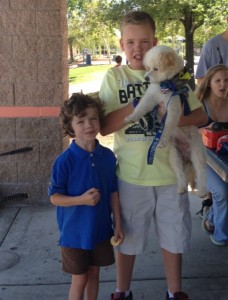
Joseph, an autistic boy from Portland, Ore., can’t wait to get a service dog trained for him by Autism Service Dogs of America.
His mother, Marne, can’t wait, either. She says the dog, after months of training, will help soothe Joseph’s anxiety and prevent meltdowns.
Sometimes, a dog undergoes up to a year of training before serving this critical role in a child’s life. Sometimes, the dog makes an appearance in a child’s life, the child and dog become close, and the magic happens on its own.
That’s the case with Tristen Doose, an 11-year-old with mild autism who also has occasional seizures. His parents, owners of Von Haus-Doose Working Dogs, rescued a stray Maltepoo, Benji, and Tristen and the dog formed a tight bond quickly.
“You can’t turn every dog into a service dog,” says Uwe Doose, Tristen’s dad, who has more than 30 years’ experience training dogs.
“But Tristen and Benji clicked. Tristen has meltdowns, and the dog really calms him.” Tristen also has a tendency to run, sometimes into dangerous places like streets. But with Tristen always holding the handle of Benji’s leash, the dog helps prevent him from running.
“Benji helps keep meltdowns from happening or cuts the length of meltdowns,” says Uwe Doose. “When he starts to have a meltdown, we can also distract him by getting him playing with Benji. Then he forgets about being upset.”
Tristen is helping train Benji to follow basic obedience commands as part of the Canine Good Citizen program required before a dog can become an official service dog.
“He is so proud when he accomplishes something with Benji,” says Uwe Doose.
During this process, Tristen has had a few meltdowns that prompted most of the other dogs to run from the training room. But Benji stayed to be with Tristen.
“We are seeing Benji much more focused and responsive to Tristen,” says Uwe Doose.
In addition, the Doose family is focusing on seeing if Benji can sense that Tristen is about to have a seizure. This special sense often comes about if a dog is particularly close to a person.
For example, Stephanie, a woman from Portland, Ore., who suffers from seizures, says her dog assigned himself the role of sensing that she is about to have a seizure, and to alert her before it happens. He barks, jumps on her and paws at her, she says. As a result of this special ability, the dog is now an official service dog whom she can take everywhere.
“Dogs can sense something before it happens,” says Ewe Doose.
Diabetic kids also benefit from service dogs, say Dr. Dana Hardin, medical director and pediatric endocrinologist at Eli Lilly. She trains service dogs to sense drops in kids’ blood sugar. The kids’ canine companions sound the alarm by trying to “tell” diabetic kids and people around them that something is wrong. Some dogs do this naturally–if they’re really bonded with the child. Others can be trained to alert kids and parents, which can prevent the child from becoming unconscious.
“After a few years of having diabetes, kids don’t always recognize that their blood sugar is low,” says Hardin. “If their blood sugar continues to drop, their brain doesn’t work well and they can become unconscious. It’s critical for kids to know when they have low blood sugar.”
Dogs possess this remarkable ability to aid diabetic children because they smell drops in blood sugar. “We know it’s something they smell, but don’t know exactly what they smell,” Hardin explains. “Dogs have a very sensitive sense of smell. They can smell changes in blood sugar even though there’s deodorant, perfumes, and other scents all around them.”
Hardin’s grandmother was a diabetic, and her dog, a dachshund, always alerted her when her blood sugar was low. He jumped on her, and if she didn’t pay attention, he would go get someone to help.
Dogs help kids and adults in so many ways that are magical! Visit us at BashAndLucy.com to learn more about children and dogs, and also to learn about the special dog, Lucy, in our dog picture book. She helps instill confidence in the boys on a sports team even though she’s not a service dog!
